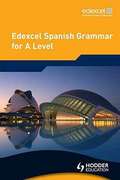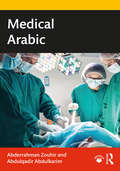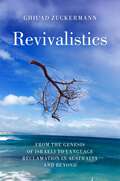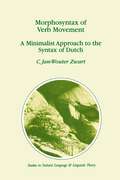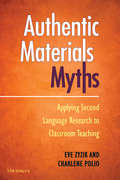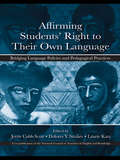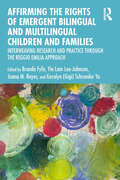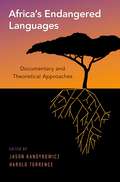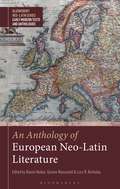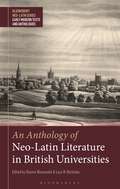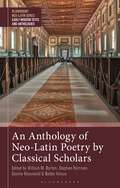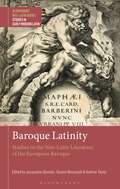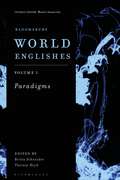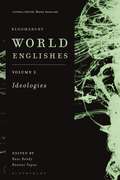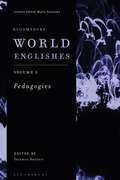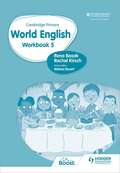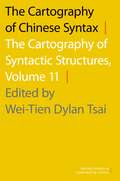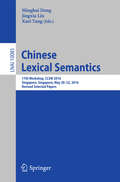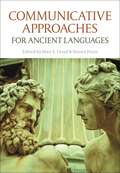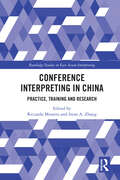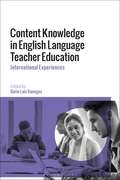- Table View
- List View
Edexcel Spanish Grammar for A Level (PDF)
by Mike Zollo Turk PhilEdexcel Spanish Grammar for A Level is a comprehensive grammar reference textbook for students studying for Edexcel A level Spanish. It takes a contemporary approach to language and gives plenty of practice with graded reinforcement exercises. Our contents grid aligns to the latest Edexcel GCE A Level specification, highlighting the language and grammatical structures you need for the AS and A2 exam.
Medical Arabic
by Abderrahman Zouhir Abdulqadir AbdulkarimMedical Arabic is a valuable resource for students interested in learning medical Arabic at ACTFL level Advanced Low. Effective communication is essential in health care, and communication is most effective when both parties share a common language, therefore resulting in a comfortable relationship between health care provider and patient. This textbook is intended for those with prior knowledge of Arabic language and grammar. It is designed to provide students with the linguistic and cultural competencies and medical Arabic terminology necessary to communicate in medical settings such as a hospital, clinic, or a community health care facility. Students will be able to ask questions in Arabic and provide answers in common medical situations, conduct patient interviews, and understand a wider variety of possible responses from patients. The book provides clear explanations of medical vocabulary and concepts as they occur in the reading materials to encourage active interaction with the text. The book’s drills are designed as either in-class exercises or homework. The answer key for the book exercises is also provided as a downloadable e-resource. Written by dynamic authors who taught Arabic as a foreign language for several years and reviewed by physicians and professionals in the field, the book is an essential guide for students in medical school, biology, and other science majors. Students will find Medical Arabic more than merely a textbook but rather a pathway to enhance their communication skills effectively.
Medical Arabic
by Abderrahman Zouhir Abdulqadir AbdulkarimMedical Arabic is a valuable resource for students interested in learning medical Arabic at ACTFL level Advanced Low. Effective communication is essential in health care, and communication is most effective when both parties share a common language, therefore resulting in a comfortable relationship between health care provider and patient. This textbook is intended for those with prior knowledge of Arabic language and grammar. It is designed to provide students with the linguistic and cultural competencies and medical Arabic terminology necessary to communicate in medical settings such as a hospital, clinic, or a community health care facility. Students will be able to ask questions in Arabic and provide answers in common medical situations, conduct patient interviews, and understand a wider variety of possible responses from patients. The book provides clear explanations of medical vocabulary and concepts as they occur in the reading materials to encourage active interaction with the text. The book’s drills are designed as either in-class exercises or homework. The answer key for the book exercises is also provided as a downloadable e-resource. Written by dynamic authors who taught Arabic as a foreign language for several years and reviewed by physicians and professionals in the field, the book is an essential guide for students in medical school, biology, and other science majors. Students will find Medical Arabic more than merely a textbook but rather a pathway to enhance their communication skills effectively.
Revivalistics: From the Genesis of Israeli to Language Reclamation in Australia and Beyond
by Ghil'ad ZuckermannIn this book, Ghil'ad Zuckermann introduces revivalistics, a new trans-disciplinary field of enquiry surrounding language reclamation, revitalization, and reinvigoration. Applying lessons from the Hebrew revival of the late nineteenth and early twentieth centuries to contemporary endangered languages, Zuckermann takes readers along a fascinating and multifaceted journey into language revival and provides new insights into language genesis. Beginning with a critical analysis of Israeli-the language resulting from the Hebrew revival-Zuckermann's radical theory contradicts conventional accounts of the Hebrew revival and challenges the family tree model of historical linguistics. Revivalistics demonstrates how grammatical cross-fertilization with the revivalists' mother tongues is inevitable in the case of successful "revival languages." The second part of the book then applies these lessons from the Israeli language to revival movements in Australia and globally, describing the "why" and "how" of revivalistics. With examples from the Barngarla Aboriginal language of South Australia, Zuckermann proposes ethical, aesthetic, and utilitarian reasons for language revival and offers practical methods for reviving languages. Based on years of the author's research, fieldwork, and personal experience with language revivals all over the globe, Revivalistics offers ground-breaking theoretical and pragmatic contributions to the field of language reclamation, revitalization, and reinvigoration.
Revivalistics: From the Genesis of Israeli to Language Reclamation in Australia and Beyond
by Ghil'ad ZuckermannIn this book, Ghil'ad Zuckermann introduces revivalistics, a new trans-disciplinary field of enquiry surrounding language reclamation, revitalization, and reinvigoration. Applying lessons from the Hebrew revival of the late nineteenth and early twentieth centuries to contemporary endangered languages, Zuckermann takes readers along a fascinating and multifaceted journey into language revival and provides new insights into language genesis. Beginning with a critical analysis of Israeli-the language resulting from the Hebrew revival-Zuckermann's radical theory contradicts conventional accounts of the Hebrew revival and challenges the family tree model of historical linguistics. Revivalistics demonstrates how grammatical cross-fertilization with the revivalists' mother tongues is inevitable in the case of successful "revival languages." The second part of the book then applies these lessons from the Israeli language to revival movements in Australia and globally, describing the "why" and "how" of revivalistics. With examples from the Barngarla Aboriginal language of South Australia, Zuckermann proposes ethical, aesthetic, and utilitarian reasons for language revival and offers practical methods for reviving languages. Based on years of the author's research, fieldwork, and personal experience with language revivals all over the globe, Revivalistics offers ground-breaking theoretical and pragmatic contributions to the field of language reclamation, revitalization, and reinvigoration.
Morphosyntax of Verb Movement: A Minimalist Approach to the Syntax of Dutch (Studies in Natural Language and Linguistic Theory #39)
by J.-W. ZwartMorphosyntax of Verb Movement discusses the phenomenon of Dutch, present in many Germanic languages, that the finite verb is fronted in main clauses but not in embedded clauses. The theoretical framework adopted is the so-called Minimalist Program of Chomsky (1995), the latest developmental stage of generative grammar. Taking issue with previous analyses, the author argues that phrase structure in Dutch is uniformly head initial, and that the finite verb moves to different positions in subject initial main clauses and in inversion constructions. The book contains lucid and detailed discussion of many theoretical issues in connection with the Minimalist Program, such as the relation between syntax and morphology, the nature of syntactic licensing, and the structure of the functional domain. At the same time, it offers a survey of the properties of Dutch syntax, a discussion of previous analyses of Dutch syntax and a wealth of material from dialects of Dutch and other Germanic languages.
Authentic Materials Myths: Applying Second Language Research to Classroom Teaching
by Eve Zyzik Charlene PolioThe use of authentic materials in language classrooms is sometimes discussed as a reliable way to expose students to the target language, but there is also disagreement regarding what kinds of authentic materials should be used, when they should be used, and how much of the curriculum should revolve around them. This volume in the Myths series explores the research related to the use of authentic materials and the ways that authentic materials may be used successfully in the classroom. Like others in the Myths series, this book combines research with good pedagogical practices. The myths examined in this book are: Authentic texts are inaccessible to beginners. Authentic texts cannot be used to teach grammar. Shorter texts are more beneficial for language learners. Activating background knowledge or making a word list is sufficient to prepare students for authentic texts. Authentic texts can be used to teach only listening and reading. Modifying or simplifying authentic texts always helps language learners. For learners to benefit from using authentic texts, the associated tasks must also be authentic. The Epilogue explores the challenges of using authentic texts in the classroom and calls for more research.
Affirming Students' Right to their Own Language: Bridging Language Policies and Pedagogical Practices
A Co-publication of the National Council of Teachers of English and Routledge. How can teachers make sound pedagogical decisions and advocate for educational policies that best serve the needs of students in today’s diverse classrooms? What is the pedagogical value of providing culturally and linguistically diverse students greater access to their own language and cultural orientations? This landmark volume responds to the call to attend to the unfinished pedagogical business of the NCTE Conference on College Composition and Communication 1974 Students’ Right to Their Own Language resolution. Chronicling the interplay between legislated/litigated education policies and language and literacy teaching in diverse classrooms, it presents exemplary research-based practices that maximize students' learning by utilizing their home-based cultural, language, and literacy practices to help them meet school expectations. Pre-service teachers, practicing teachers, and teacher educators need both resources and knowledge, including global perspectives, about language variation in PreK-12 classrooms and hands-on strategies that enable teachers to promote students’ use of their own language in the classroom while also addressing mandated content and performance standards. This book meets that need. Visit http://www.ncte.org for more information about NCTE books, membership, and other services.
Affirming the Rights of Emergent Bilingual and Multilingual Children and Families: Interweaving Research and Practice through the Reggio Emilia Approach
Affirming the Rights of Emergent Bilingual and Multilingual Children and Families explores how the philosophy, principles, and practices of the internationally acclaimed Municipal Preschools and Infant Toddler Centers of Reggio Emilia, Italy, advance the social justice and linguistic human rights of emergent bilingual and multilingual children and their families, particularly immigrants and refugees. The book is driven by the authors’ research-based discourse including an interview with Reggio Emilia educators and direct observations in the Preschools and Infant–toddler Centers in Italy. Chapters include survey and follow-up interviews, and classroom examples from U.S. early childhood educators inspired by the Reggio Emilia approach some of whom are in multilingual settings. Recommendations are included for practitioners who are intentional about advocating for the rights of emergent bi- and multilingual young children. Also included are the researchers’ interpretations and reflexive narratives on contextuality, intersectionality, and intertextuality, which interweave theories and practice. The insightful examinations of scholarly work and the critical review of the distinctive features of the Reggio Emilia philosophy contribute to an early childhood education transformative lens that challenges the status quo of inequities and foregrounds the linguistic and cultural rights of learners who speak different languages. The authors review research and theory that inform the latest developments in culturally and linguistically responsive practices in innovative early education (infant through pre-k), family participation, and teacher preparation and development. Of general interest to educators and researchers around the world who work to ensure the rights of emergent language learners, this is an essential text for upper-level and graduate students, early childhood educators, educational and community leaders, administrators, and researchers.
Africa's Endangered Languages: Documentary and Theoretical Approaches
Relatively little is known about Africa's endangered languages. Unlike indigenous languages in Australia, North Asia, and the Americas, which are predominantly threatened by colonizers, African languages are threatened most immediately by other local languages. As a result, the threat of language extinction is perceived as lower in Africa than in other parts of the globe, and a disproportionate amount of research is devoted to the study of endangered African languages when compared to any other linguistically threatened region in the world. There are approximately 308 highly endangered languages spoken in Africa (roughly 12% of all African languages) and at least 201 extinct African languages. This volume hopes to illuminate and challenge this trend. Chapters offer both documentary and theoretical perspectives, emphasizing the symbiotic relationship between the two approaches and its implications for the preservation of endangered languages, both in the African context and more broadly. Documentary-oriented chapters deal with key issues in African language documentation including language preservation and revitalization, community activism, and data collection and dissemination methodologies, among others. Theoretically-oriented chapters provide detailed descriptions and analyses of phonetic, phonological, morphological, syntactic, and semantic phenomena, and connect these to current theoretical issues and debates. Africa's Endangered Languages provides thorough coverage of a continent's neglected languages that will spur linguists and Africanists alike to work to protect them.
The Ancient Sea: The Utopian and Catastrophic in Classical Narratives and their Reception
In the ancient Mediterranean world, the sea was an essential domain for trade, cultural exchange, communication, exploration, and colonisation. In tandem with the lived reality of this maritime space, a parallel experience of the sea emerged in narrative representations from ancient Greece and Rome, of the sea as a cultural imaginary. This imaginary seems often to oscillate between two extremes: the utopian and the catastrophic; such representations can be found in narratives from ancient history, philosophy, society, and literature, as well as in their post-classical receptions. Utopia can be found in some imaginary island paradise far away and across the distant sea; the sea can hold an unknown, mysterious, divine wealth below its surface; and the sea itself as a powerful watery body can hold a liberating potential. The utopian quality of the sea and seafaring can become a powerful metaphor for articulating political notions of the ideal state or for expressing an individual’s sense of hope and subjectivity. Yet the catastrophic sea balances any perfective imaginings: the sea threatens coastal inhabitants with floods, tsunamis, and earthquakes and sailors with storms and the accompanying monsters. From symbolic perspectives, the catastrophic sea represents violence, instability, the savage, and even cosmological chaos. The twelve papers in this volume explore the themes of utopia and catastrophe in the liminal environment of the sea, through the lens of history, philosophy, literature and classical reception.Contributors: Manuel Álvarez-Martí-Aguilar, Vilius Bartninkas, Aaron L. Beek, Ross Clare, Gabriele Cornelli, Isaia Crosson, Ryan Denson, Rhiannon Easterbrook, Emilia Mataix Ferrándiz, Georgia L. Irby, Simona Martorana, Guy Middleton, Hamish Williams.
An Anthology of European Neo-Latin Literature (Bloomsbury Neo-Latin Series: Early Modern Texts and Anthologies)
Compiled by a team of international experts, this volume showcases the best of the huge abundance of literature written in Latin in Europe from about 1500 to 1800. A general introduction provides readers with the context they need before diving into the 19 high-quality short Latin extracts and English translations. Together these texts present a rich panorama of the different literary genres, styles and themes that flourished at the time, and include authors such as Erasmus, Buchanan, Leibniz and Newton, along with less well-known writers.From the vast array of material available, a varied and meaningful sample of texts has been carefully curated by the editors of the volume. Passages not only exhibit literary merit or historical importance, but also illustrate the role of the complete texts from which they have been selected in the development of Neo-Latin literature. They reflect the wide range of authors writing in Latin in early modern Europe, as well as the importance of Latin in the history of ideas.As with all volumes in the series, section introductions and accompanying notes on every text provide orientation on the material for students.
An Anthology of Neo-Latin Literature in British Universities (Bloomsbury Neo-Latin Series: Early Modern Texts and Anthologies)
Compiled by a team of experts in the field, this volume brings to view an array of Latin texts produced in British universities from c.1500 to 1700. It includes a comprehensive introduction to the production of Neo-Latin and Neo-Greek in the early modern university, the precise circumstances and broader environments that gave rise to it, plus an associated bibliography. 12 high-quality sections, each prefaced by its own short introduction, set forth the Latin (and occasionally Greek) texts and accompanying English translations and notes. Each section provides focused orientation and is arranged in such a way as to ensure the volume's accessibility to scholars and students at all levels of familiarity with Neo-Latin. Passages are taken from documents that were composed in seats of learning across the British Isles, in Oxford, Cambridge, Dublin, Edinburgh and St Andrews, and adduce a wide range of material from orations and disputational theses to collections of occasional verse, correspondence, notebooks and university drama. This anthology as a whole conveys a sense of the extent of Latin's role in the academy and the span of remits in which it was deployed. Far from simply offering a snapshot of discrete projects, the contributions collectively offer insights into the broader culture of the early modern university over an extended period. They engage with the administrative operations of institutions, pedagogical processes and academic approaches, but also high-level disputes and the universities' relationship with the worlds of politics, new science and intellectual developments elsewhere in Europe.
An Anthology of Neo-Latin Poetry by Classical Scholars (Bloomsbury Neo-Latin Series: Early Modern Texts and Anthologies)
Presenting a range of Neo-Latin poems written by distinguished classical scholars across Europe from c. 1490 to c. 1900, this anthology includes a selection of celebrated names in the history of scholarship. Individual chapters present the Neo-Latin poems alongside new English translations (usually the first) and accompanying introductions and commentaries that annotate these verses for a modern readership, and contextualise them within the careers of their authors and the history of classical scholarship in the Renaissance and early modern period.An appealing feature of Renaissance and early modern Latinity is the composition of fine Neo-Latin poetry by major classical scholars, and the interface between this creative work and their scholarly research. In some cases, the two are actually combined in the same work. In others, the creative composition and scholarship accompany each other along parallel tracks, when scholars are moved to write their own verse in the style of the subjects of their academic endeavours. In still further cases, early modern scholars produced fine Latin verse as a result of the act of translation, as they attempted to render ancient Greek poetry in a fitting poetic form for their contemporary readers of Latin.
Baroque Latinity: Studies in the Neo-Latin Literature of the European Baroque (Bloomsbury Neo-Latin Series: Studies in Early Modern Latin)
This volume addresses the idea of the Baroque in European literature in Latin. With contributions by scholars from various disciplines and countries, and by looking at a range of texts from across Europe, the volume offers case studies to deepen scholarly understanding of this important literary phenomenon and inspire future research. A key aim of the volume is to address the distinctiveness of these texts by interrogating the usefulness and specificity of the term 'Baroque', especially in relation to the classical rules it transgresses to produce effects of grandeur, richness, and exuberance in a range of secular and sacred arts (e.g. music, architecture, painting), as well as various forms of literature (e.g. prose, poetry, drama). The contributors consider how and why Latin writing mutated from earlier humanist paradigms, thus exploring how ideas of 'early modern' and 'Baroque' are related, and examine the interplay of the theory and practice of the 'Baroque', including its debts to and deviations from ancient models, and its limits and limitations.
Bloomsbury World Englishes Volume 1: Paradigms
Bloomsbury World Englishes offers a comprehensive and rigorous description of the facts, implications and contentious issues regarding the forms and functions of English in the world. International experts cover a diverse range of varieties and topics, offering a more accurate understanding of English across the globe and the various social contexts in which it plays a significant role. With volumes dedicated to research paradigms, language ideologies and pedagogies, the collection pushes the boundaries of the field to go beyond traditional descriptive paradigms and contribute to moving research agendas forward. Volume 1: Paradigms analyzes the ways in which we make sense of English as a global language, its many varieties and how these come into contact and interact with other languages. It moves the field beyond existing 'models' that are no longer sufficient to describe English(es) in the era of globalization.
Bloomsbury World Englishes Volume 2: Ideologies
Bloomsbury World Englishes offers a comprehensive and rigorous description of the facts, implications and contentious issues regarding the forms and functions of English in the world. International experts cover a diverse range of varieties and topics, offering a more accurate understanding of English across the globe and the various social contexts in which it plays a significant role. With volumes dedicated to research paradigms, language ideologies and pedagogies, the collection pushes the boundaries of the field to go beyond traditional descriptive paradigms and contribute to moving research agendas forward.Volume 2: Ideologies explores the politics and economics of English, and the impact of language on local societies and cultures. In doing so, chapters discuss how English is often entangled in societal issues, such as inequality, (de-)colonization, racism, oppression and liberation.
Bloomsbury World Englishes Volume 3: Pedagogies
Bloomsbury World Englishes offers a comprehensive and rigorous description of the facts, implications and contentious issues regarding the forms and functions of English in the world. International experts cover a diverse range of varieties and topics, offering a more accurate understanding of English across the globe and the various social contexts in which it plays a significant role. With volumes dedicated to research paradigms, language ideologies and pedagogies, the collection pushes the boundaries of the field to go beyond traditional descriptive paradigms and contribute to moving research agendas forward. Volume 3: Pedagogies addresses the teaching of English as a world language. Chapters in this volume consider the teaching and learning of English(es) from a range of perspectives and on the basis of experiences and research from many parts of the world.
Body Technologies in the Greco-Roman World: Technosôma, gender and sex
A collection of papers that introduces the notion of the technosoma (techno body) into discussions on the representations of the body in classical antiquity. By applying the category of the technosoma to the ‘natural’ body, this volume explicitly narrows down the discussion of the technical and the natural to the physiological body. In doing so, the present collection focuses on body technologies in the specific form of beautification and body enhancement techniques, as well as medical and surgical treatments. The volume elucidates two main points. Firstly, ancient techno bodies show that the categories of gender and sexuality are at the core of the intersection of the natural and the technical, and intersect with notions of race, age, speciesism, class and education, and dis/ability. Secondly, the collection argues that new body technologies have in fact a very ancient history that can help to address the challenges of contemporary technological innovation. To this end, the volume showcases the intersection of ‘natural’ bodies with technology, gender, sexuality and reproduction. On the one hand, techno bodies tend to align with normative ideas about gender, and sexuality. On the other hand, body modification and/or enhancement techniques work hand in hand with economic and political power and knowledge, thus they often produce techno bodies that are shaped according to individual needs, i.e. according to a certain lifestyle. Consequently, techno bodies threaten to alter traditional ideas of masculinity, femininity, male and female sexuality and beauty.
Cambridge Primary World English: Workbook Stage 5
This title has been endorsed by Cambridge Assessment International Education Support knowledge and understanding from the Learner's Book with practical workbooks designed to challenge learners to develop their thinking further.- Save time when planning with ready-made homework or extension exercises.- Challenge learners to develop their learning further with practice activities. - Ensure mastery with clear coverage of key language skills: grammar, spelling, vocabulary, reading and writing.- Develop and expand knowledge, ensuring learners master the skills, language systems and vocabulary from every unit.
The Cartography of Chinese Syntax: The Cartography of Syntactic Structures, Volume 11 (Oxford Studies in Comparative Syntax)
This edited volume provides new insights into the architecture of Chinese grammar from a comparative perspective, using principles of cartography. Cartography is a research program within syntactic theory that is guided by the view that syntactic structures contain grammatical and functional information that is ideal for semantic interpretation - by studying the syntactic structures of a particular language, syntacticians can better understand the semantic issues at play in that language. The chapters in this book map out the "topography" of a variety of constructions in Chinese, specifically information structure, wh-question formation, and peripheral functional elements. The syntactic structure of Chinese makes it an ideal language for this line of research, because functional elements are often spread throughout sentences rather than clumped together as is usually dictated by language-specific morphology. Mapping Chinese syntactic structures therefore offers a window into the origin of heavily "scrambled" constructions often observed in other languages. The book includes a preface that will discusses the goal of cartography and explains how the collection contributes towards our understanding of this approach to syntax. The subsequent seven original articles all contain original syntactic data that is invaluable for future research in cartography, and the collection as a whole paints a broader picture of how the alignment between syntax and semantics works in a principled way.
Chinese Lexical Semantics: 17th Workshop, CLSW 2016, Singapore, Singapore, May 20–22, 2016, Revised Selected Papers (Lecture Notes in Computer Science #10085)
This book constitutes the thoroughly refereed post-workshop proceedings of the 17th Chinese Lexical Semantics Workshop, CLSW 2016, held in Singapore, Singapore, in May 2016. The 70 regular papers included in this volume were carefully reviewed and selected from 182 submissions. They are organized in topical sections named: lexicon and morphology, the syntax-semantics interface, corpus and resource, natural language processing, case study of lexical semantics, extended study and application.
Communicative Approaches for Ancient Languages
This book is the first in its field. It showcases current and emerging communicative practices in the teaching and learning of ancient languages (Latin and Greek) across contemporary education in the US, the UK, South America and continental Europe. In all these parts of the globe, communicative approaches are increasingly being accepted as showing benefits for learners in school, university and college classrooms, as well as at specialist conferences which allow for total immersion in an ancient language. These approaches are characterised by interaction with others using the ancient language. They may include various means and modalities such as face-to-face conversations and written communication. The ultimate aim is to optimise the facility to read such languages with comprehension and engagement.The examples showcased in this volume provide readers with a vital survey of the most current issues in communicative language teaching, helping them to explore and consider adoption of a wider range of pedagogical practices, and encouraging them to develop tools to promote engagement and retention of a wider variety of students than currently find ancient languages accessible. Both new and experienced teachers and learners can build on the experiences and ideas in this volume to explore the value of these approaches in their own classrooms.
Conference Interpreting in China: Practice, Training and Research (Routledge Studies in East Asian Interpreting)
In this landmark project, Moratto and Zhang evaluate how conference interpreting developed as a profession in China, and the directions in which it is heading. Bringing together perspectives from leading researchers in the field, Moratto and Zhang present a thematically organized analysis of the trajectory of professional conference interpreting in China. This includes discussion of the pedagogies used both currently and historically, the professionalization of interpreter education, and future prospects for virtual reality, multimodal conferences, and artificial intelligence. Taken as a whole, the contributors present a rich and detailed picture of the development of conference interpreting in China since 1979, its status today, and how it is likely to develop in the coming decades. An essential resource for scholars and students of conference interpreting in China, alongside its sister volume, The Pioneers of Chinese Interpreting: Insiders’ Accounts on the Rise of a Profession.
Content Knowledge in English Language Teacher Education: International Experiences
Content Knowledge in English Language Teacher Education provides original professional experiences and research accounts of teaching language in the specific context of English language teacher education programmes in diverse international settings, with contributions from Argentina, Australia, Chile, China, Ecuador, Japan, Mexico, the USA and Turkey. The volume focuses on how teacher educators plan and deliver modules which help future teachers understand English as a system and develop English language proficiency. The contributors describe and analyse their professional practices in designing, delivering and evaluating modules or courses on understanding the English language as a system, i.e. content knowledge, exploring the teaching of elements such as phonetics, phonology, grammar, pragmatics, philology, and discourse analysis. In addition, they draw on their vast professional experience to explore how to successfully develop competence and language skills in English so that teachers can become models and proficient users of the language for their students. The contributions range from more historical and functionally linguistic focused chapters to more sociocultural explorations of teaching English to future teachers including interculturality, multilingualism, World Englishes, critical thinking skills, academic writing, and literacy through literature. The accounts shed light on the diverse practices of educators from many different countries, contexts, and cultural and linguistic backgrounds, drawing links between policy and practice, to locate much of English language teacher education and curriculum development outside the so-called 'inner circle' of native English-language speaking contexts, practitioners, and researchers.
